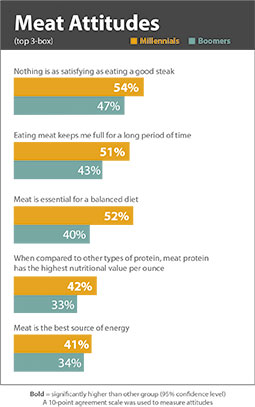Last updated on October 5th, 2016 at 08:25 am
New research from Midan Marketing explores how Millennials’ meat consumption differs from that of Baby Boomers
One of the largest generations in U.S. history is moving quickly into its prime spending years and forcing companies to re-evaluate the way they do business. Currently, the size of the U.S. Millennial market is 75.4 million, according to a Pew Research Center article entitled, “Millennials overtake Baby Boomers as America’s largest generation.”
Millennials are a complex generation; they are highly praised for their transformative purpose in life, their strong interest in health and wellness, their high social consciousness and interest in protecting the environment. However, Millennials also are often criticized for their intolerance for norms and institutions, their self-centered focus and their tendency to choose meaning over more traditional pursuits like career, home ownership or money.
Nevertheless, there is no doubt that Millennials are creating their own path and challenging every business and institution, including the meat industry.
To understand Millennials’ meat consumption, as well as their attitudes and perceptions about meat, Midan Marketing conducted an online study with 425 Millennials and 400 Boomers (as a comparison point) in May 2016. The overwhelming majority of both Millennials and Boomers had consumed some type of meat in the past month—95 and 96 percent, respectively. Both groups responded to similar questions about their meat consumption, preferences and attitudes toward meat and health.
As a group, the Midan study found that Millennials consume fresh meat (all types included) at similar levels as their preceding generations (Gen Y and Boomers). However, as Millennials move into their prime spending years, get married and start families, their consumption is expected to increase.
In order to better understand Millennials’ relationship with meat, Midan Marketing compared Millennials and Boomers in 12 important areas. Following is a list of the most relevant areas of interest for the meat industry, and how the two generations compare:
1. At-home meal preparation: Millennials are more engaged than Boomers
Millennials feel a sense of accomplishment when they prepare a complicated dish (76 percent vs. 58 percent of Boomers) and enjoy trying new meat recipes (62 percent vs. 49 percent of Boomers). They also are willing to pay more for high-quality ingredients than Boomers (55 percent vs. 37 percent).
2. Changes in meat consumption: Millennials’ meat consumption is not stable
Boomers exhibit more stable meat consumption than Millennials. Seventy-nine percent of Boomers are consuming about the same amount of meat and poultry as last year compared to 67 percent of Millennials. Among those changing consumption, some Millennials have increased meat consumption in past 12 months (11 percent) but others have decreased meat consumption (22 percent). Boomers are more likely to decrease consumption (16 percent) than increase it (5 percent).
3. Reasons for decreasing meat consumption: health concerns are top reason for both groups
Boomers’ top three reasons for decreasing consumption are related to health (36 percent), the increasing cost of meat (38 percent) and their own economic situation (31 percent). By contrast, Millennials’ top reasons for decreasing meat consumption are health concerns (30 percent), animal welfare (23 percent), environmental concerns (23 percent) and social influences (22 percent).
4. Monthly meat spending: Millennials’ spending is significantly higher than Boomers’
In an average month, Millennials spend significantly more on meat than Boomers ($162 vs. $93). This can be explained by two important differences between these groups: one, Millennials have larger households (and growing families), and two, they purchase proportionally more prepared meats than Boomers.
5. Fresh vs. prepared meat consumption: Millennials buy significantly more prepared meat than Boomers
Boomers purchase significantly more fresh/unprepared meat (78 percent) than Millennials (56 percent). Both groups prefer fresh meat rather than frozen. Prepared meat accounts for about 44 percent of Millennials’ meat purchases; in comparison, only 22 percent of meat purchases among Boomers are prepared meats.
 6. Attitudes toward meat: Both groups have positive attitudes toward meat, with a few important differences
6. Attitudes toward meat: Both groups have positive attitudes toward meat, with a few important differences
Boomers have a stronger preference for meat produced and packaged in the U.S. than Millennials (70 percent vs. 61 percent). They also are more likely to say that they cannot imagine giving up the taste of meat (62 percent of Boomers vs. 55 percent of Millennials surveyed). On the other hand, Millennials have stronger opinions about meat in other areas.
Editor’s note: This is the first of a two-part story, which is featured in its entirety in the September print editions of The Shelby Report. Part 2 will appear online in the coming weeks.







5 Comments